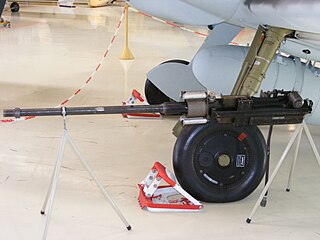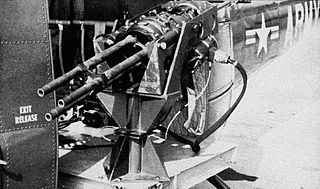
The Bell AH-1 Cobra is a two-blade, single-engine attack helicopter manufactured by Bell Helicopter. It was developed using the engine, transmission and rotor system of the Bell UH-1 Iroquois. A member of the prolific Huey family, the AH-1 is also referred to as the HueyCobra or Snake.

A gunship is a military aircraft armed with heavy guns, primarily intended for attacking ground targets.

The Objective Individual Combat Weapon or OICW was the next-generation service rifle competition that was under development as part of the United States Army OICW program; the program was eventually discontinued without bringing the weapon out of the prototype phase. The acronym OICW is often used to refer to the entire weapons program.

The MG 151 was a 15 mm aircraft-mounted autocannon produced by Waffenfabrik Mauser during World War II. Its 20mm variant, the 20 mm MG 151/20 cannon, was widely used on German Luftwaffe fighters, night fighters, fighter-bombers, bombers and ground-attack aircraft. Salvaged guns saw post-war use by other nations.

The Mk 19 grenade launcher is an American 40 mm belt-fed automatic grenade launcher that was first developed during the Vietnam War. The first model in 1966 was determined to be unreliable and unsafe, but a total of six Mod 1 launchers were successfully tested on U.S. Navy riverine patrol craft in the Mekong Delta in 1972. The Navy made further improvements to the weapon, resulting in the Mod 3 in 1976. The Mod 3 was adopted by the U.S. Army in 1983 and remains in service to the present day.

The M197 electric cannon is a 20 mm three-barreled electric Gatling-type rotary cannon used by the United States military.

The Hughes M230 Chain Gun is a 30 mm, single-barrel automatic cannon developed by Hughes and now manufactured by Orbital ATK. It is an electrically operated chain gun, a weapon that uses external electrical power to cycle the weapon between shots.
The Special Purpose Individual Weapon (SPIW) was a long-running United States Army program to develop, in part, a workable flechette-firing "rifle", though other concepts were also involved. The concepts continued to be tested under the Future Rifle Program and again in the 1980s under the Advanced Combat Rifle program, but neither program resulted in a system useful enough to warrant replacing the M16.
The M134 Minigun is a 7.62×51mm NATO six-barrel rotary machine gun with a high, sustained rate of fire. It features a Gatling-style rotating barrel assembly with an external power source, normally an electric motor. The "Mini" in the name is in comparison to larger-caliber designs that use a rotary barrel design, such as General Electric's earlier 20 mm M61 Vulcan, and "gun" for the use of rifle caliber bullets as opposed to autocannon shells.

The AGS-17Plamya is a Soviet-designed automatic grenade launcher in service worldwide.

The 40 mm grenade is a military grenade caliber for grenade launchers in service with many armed forces. There are two main types in service: the 40×46mm, which is a low-velocity round used in hand-held grenade launchers; and the high-velocity 40×53mm, used in mounted and crew-served weapons. The cartridges are not interchangeable. Both 40 mm cartridges use the High-Low Propulsion System.

The XM214 is an American prototype 5.56 mm rotary-barreled machine gun. It was designed and built by General Electric. Also known as Microgun, the XM214 was a scaled-down smaller and lighter version of the M134 minigun, firing M193 5.56×45mm ammunition.

The XM307 Advanced Crew Served Weapon (ACSW) was a developmental 25 mm belt-fed automatic grenade launcher with smart airburst capability. It is the result of the OCSW or Objective Crew Served Weapon project. It is lightweight and designed to be two-man portable, as well as vehicle mounted. The XM307 can kill or suppress enemy combatants out to 2,000 meters, and destroy lightly armored vehicles, watercraft, and helicopters at 1,000 meters. The project was canceled in 2007.

The United States Army has created a plethora of different types of 40 mm grenades in both the low-velocity 40×46mm and high-velocity 40×53mm calibers which uses what it calls High-Low Propulsion System which keeps recoil forces within the boundaries of an infantry weapon. Presented on this page is a basic overview.
The High-Low system, also referred to as the "High-Low Pressure system", the "High-Low Propulsion System", and the "High-Low projection system", is a design of cannon and antitank launcher using a smaller high-pressure chamber for storing the propellant. It enables a much larger projectile to be launched without the heavy equipment typically required for large caliber weapons. When the propellant is ignited, the higher pressure gases are bled out through vents at reduced pressure to a much larger low pressure chamber to push the projectile forward. With the High-Low System a weapon can be designed with reduced or negligible recoil. The High-Low System also allows the weight of the weapon and its ammunition to be significantly reduced. Manufacturing cost and production time are drastically lower than for standard cannon or other small-arm weapon systems firing a projectile of the same size and weight. It has a far more efficient use of the propellant, unlike earlier recoilless weapons, where most of the propellant is expended to the rear of the weapon to counter the recoil of the projectile being fired.


















